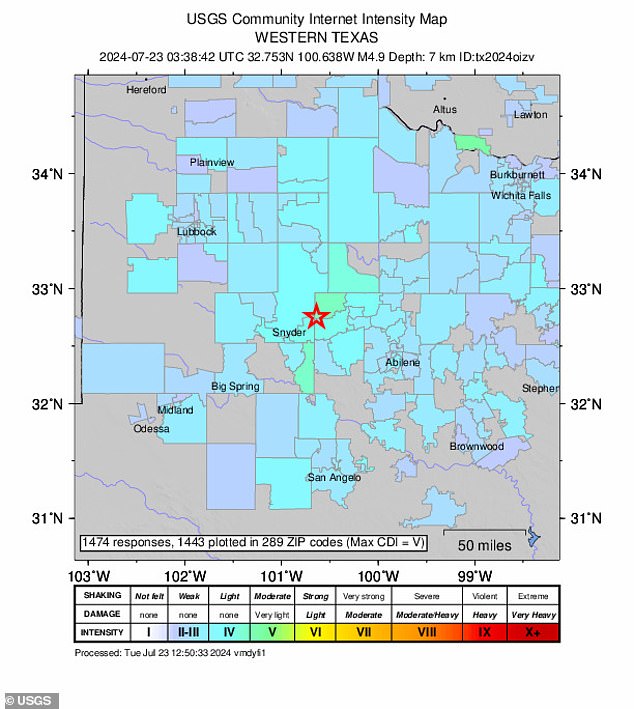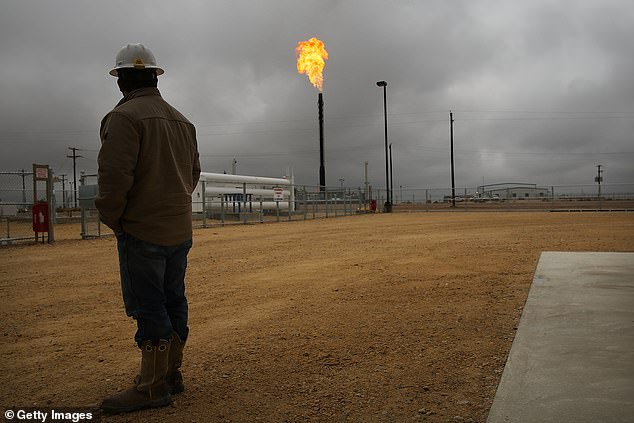Three US states are hit by a series of earthquakes measuring 3.0 to 5.0 on the Richter scale. Did you feel the quake?
Texas was hit by three earthquakes from Monday night into Tuesday morning, the strongest of which was felt 200 miles (320 kilometers) from the epicenter.
Reports of the quakes began pouring in across Texas after the first one shook people awake in Hermleigh at 10:38 p.m. The magnitude 4.9 quake was the eighth-largest in state history.
At least 1.6 million people in cities including Austin, southern Oklahoma and New Mexico witnessed the event.
Less than 10 minutes after the initial quake, a 4.4 magnitude aftershock struck. Residents experienced a 3.1 magnitude aftershock early Tuesday morning.
The USGS released a map with a star pointing to the epicenter where the quake started, near Hermleigh, and the blue outline showing where the immediate shock extended
North Texas, where Hermleigh is located, does not lie on a major fault line, but there are 250 smaller fault lines that stretch 1,800 miles (2,900 kilometers) from the Dallas-Fort Worth area to the epicenter of Monday’s quake.
The earthquake struck near the Scurry-Fisher County border, 54 miles (87 kilometers) west of Abilene and 10 miles (16 kilometers) northeast of Hermleigh.
The Geological Survey (USGS) confirmed that the earthquake began just 7.7 kilometers (4.8 miles) below the Earth’s surface.
At their deepest, earthquakes can occur as much as 640 kilometers underground.
Earthquakes that reach a distance of 69 kilometers or less are considered shallow and cause only minor to moderate damage.
According to the Volcano Discovery seismological survey, residents experienced strong shaking indoors, causing small cracks in floors and ceilings, and felt two aftershocks.
Some residents were shocked by the quakes. One person on X shouted, “Holy shit! 4.9 magnitude earthquake in Texas!!”
Someone else wrote, “Guys, I didn’t have ‘Texas earthquake’ on my bingo card for this full moon,” while someone else simply noted, “There were a bunch of tremors in Texas last night, including two earthquakes east of Snyder, including a 4.9 magnitude quake.”

A magnitude 4.9 earthquake struck northern Texas, affecting 1.6 million people as far away as Austin, southern Oklahoma and New Mexico
While much of the U.S. experiences natural earthquakes, the USGS reported that “in some regions, such as the south-central states, many seismologists believe that a large proportion of recent earthquakes are human-caused.”
These activities include storing water behind dams, injecting fluids into the earth’s crust, extracting liquids or gases, and removing rocks during mining operations.
For that reason, residents rarely experience earthquakes or tremors, but scientists suspect that the recent series of earthquakes in Texas is largely due to hydraulic fracturing, also known as fracking.
Texas is the world’s leading country in fracking. As of February 2017, there were 279,615 oil and gas wells in the state. By 2023, that number had risen to 373,133 active wells.
In this process, miners drill deep into the earth’s surface and release water under high pressure. This creates a small explosion, releasing natural gas and oil that can be used to generate energy.
The action brings groundwater to the surface and when it is injected back into the ground, it puts pressure on the fault lines, resulting in more earthquakes.

While much of the U.S. experiences natural earthquakes, the USGS reported that “in some regions, such as the south-central states, a significant portion of recent earthquakes are attributed by many seismologists to human-induced earthquakes.” Pictured: A fracking site in Garden City, Texas
Researchers report that seismic activity in Texas has increased since 2018, with 81 percent of earthquakes measuring magnitude 2.5 or greater recorded since 2020.
In 2021 alone, the state of Texas was hit by more than 200 earthquakes of magnitude three or greater, more than double the number of earthquakes the previous year.
Locals have long complained about hydraulic fracturing in the region, with one person saying they moved to central or southwest Texas to avoid the increasing number of earthquakes.
“The damage (from fracking) has been done, and now we’re just paying the price. And this is what it is,” one resident told the Texas Tribune in 2022.
